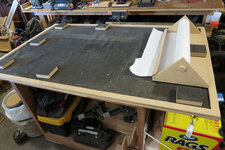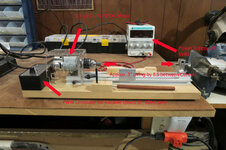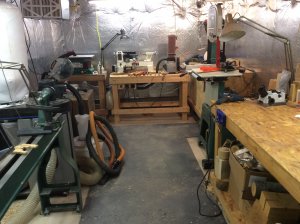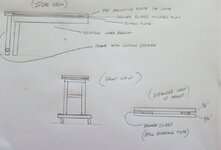gtriever
Member
The attached photo show my assembly/sanding table, which by coincidence is the ONLY place I have to set up a lathe. So, I need to be able to set a lathe up and then move it aside when I need the table for something else.
Here's the problem - I'm 67 years old and I have a bad back, combined with chronic cardiac issues that limit me to how much weight I can safely lift. That works out to around 40 - 50 pounds max. I've already had to give up building cabinets and the like. You see where I'm going with this.
I'd been looking at the Harbor Freight 10 x 18 lathe and several more in its class, but they're all 75 pounds plus. Then I came across the Shop Fox W1704 lathe, which weighs in at only 45 pounds. That might be doable. I'm aware of the shortcomings of that lathe; only 1/3 HP, only 8 x 12 (or 13, I've seen both specs), 3/4 x 16 TPI, and MT1. However I also see that it's variable speed. so, here's the skinny on it:
The things I'm interested in turning are small items such as pens, bottle stoppers, pocket watch cases, spindles for doll cabinets, and maybe some small salt and pepper mills (nothing over 8 inches). No bowls or cups... I also have zero equipment to repurpose (chucks, etc) so MT1 and 3/4 x 16 shouldn't be an issue that I can see, since MT1 and 3/4 x 16 items are available.
So after all that long-windedness, what say you, IAP members? Yeas or nays on the W1704?

Here's the problem - I'm 67 years old and I have a bad back, combined with chronic cardiac issues that limit me to how much weight I can safely lift. That works out to around 40 - 50 pounds max. I've already had to give up building cabinets and the like. You see where I'm going with this.
I'd been looking at the Harbor Freight 10 x 18 lathe and several more in its class, but they're all 75 pounds plus. Then I came across the Shop Fox W1704 lathe, which weighs in at only 45 pounds. That might be doable. I'm aware of the shortcomings of that lathe; only 1/3 HP, only 8 x 12 (or 13, I've seen both specs), 3/4 x 16 TPI, and MT1. However I also see that it's variable speed. so, here's the skinny on it:
The things I'm interested in turning are small items such as pens, bottle stoppers, pocket watch cases, spindles for doll cabinets, and maybe some small salt and pepper mills (nothing over 8 inches). No bowls or cups... I also have zero equipment to repurpose (chucks, etc) so MT1 and 3/4 x 16 shouldn't be an issue that I can see, since MT1 and 3/4 x 16 items are available.
So after all that long-windedness, what say you, IAP members? Yeas or nays on the W1704?




